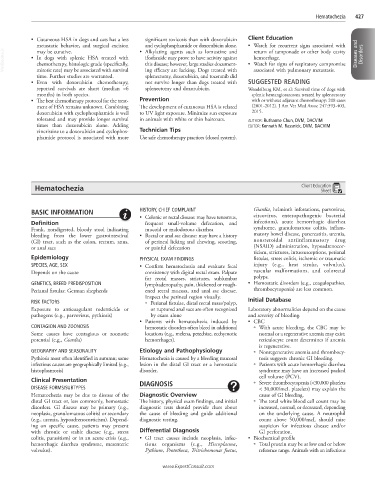Page 880 - Cote clinical veterinary advisor dogs and cats 4th
P. 880
Hematochezia 427
• Cutaneous HSA in dogs and cats has a less significant toxicosis than with doxorubicin Client Education
metastatic behavior, and surgical excision • Alkylating agents such as lomustine and • Watch for recurrent signs associated with
and cyclophosphamide or doxorubicin alone.
VetBooks.ir • In dogs with splenic HSA treated with ifosfamide may prove to have activity against • Watch for signs of respiratory compromise Diseases and Disorders
may be curative.
return of tamponade or other body cavity
hemorrhage.
this disease; however, large studies document-
chemotherapy, histologic grade (specifically,
mitotic rate) may be associated with survival
splenectomy, doxorubicin, and toceranib did
time. Further studies are warranted. ing efficacy are lacking. Dogs treated with associated with pulmonary metastasis.
• Even with doxorubicin chemotherapy, not survive longer than dogs treated with SUGGESTED READING
reported survivals are short (median ≈6 splenectomy and doxorubicin. Wendelburg KM, et al: Survival time of dogs with
months) in both species. splenic hemangiosarcoma treated by splenectomy
• The best chemotherapy protocol for the treat- Prevention with or without adjuvant chemotherapy: 208 cases
ment of HSA remains unknown. Combining The development of cutaneous HSA is related (2001-2012). J Am Vet Med Assoc 247:393-403,
doxorubicin with cyclophosphamide is well to UV light exposure. Minimize sun exposure 2015.
tolerated and may provide longer survival in animals with white or thin haircoats. AUTHOR: Ruthanne Chun, DVM, DACVIM
times than doxorubicin alone. Adding EDITOR: Kenneth M. Rassnick, DVM, DACVIM
vincristine to a doxorubicin and cyclophos- Technician Tips
phamide protocol is associated with more Use safe chemotherapy practices (closed system).
Hematochezia Client Education
Sheet
BASIC INFORMATION HISTORY, CHIEF COMPLAINT Giardia, helminth infestations, parvovirus,
• Colonic or rectal disease: may have tenesmus, circovirus, enteropathogenic bacterial
Definition frequent small-volume defecation, and infections), acute hemorrhagic diarrhea
Frank, nondigested, bloody stool indicating mucoid or malodorous diarrhea syndrome, granulomatous colitis, inflam-
bleeding from the lower gastrointestinal • Rectal or anal sac disease: may have a history matory bowel disease, pancreatitis, uremia,
(GI) tract, such as the colon, rectum, anus, of perineal licking and chewing, scooting, nonsteroidal antiinflammatory drug
or anal sacs or painful defecation (NSAID) administration, hypoadrenocor-
ticism, strictures, intussusceptions, perianal
Epidemiology PHYSICAL EXAM FINDINGS fistulas, stress colitis, ischemic or traumatic
SPECIES, AGE, SEX • Confirm hematochezia and evaluate fecal injury (e.g., heat stroke, volvulus),
Depends on the cause consistency with digital rectal exam. Palpate vascular malformations, and colorectal
for rectal masses, strictures, sublumbar polyps.
GENETICS, BREED PREDISPOSITION lymphadenopathy, pain, thickened or rough- • Hemostatic disorders (e.g., coagulopathies,
Perianal fistulas: German shepherds ened rectal mucosa, and anal sac disease. thrombocytopenia) are less common.
Inspect the perineal region visually.
RISK FACTORS ○ Perianal fistulae, distal rectal mass/polyp, Initial Database
Exposure to anticoagulant rodenticide or or ruptured anal sacs are often recognized Laboratory abnormalities depend on the cause
pathogens (e.g., parvovirus, pythiosis) by exam alone and severity of bleeding.
• Patients with hematochezia induced by • CBC
CONTAGION AND ZOONOSIS hemostatic disorders often bleed in additional ○ With acute bleeding, the CBC may be
Some causes have contagious or zoonotic locations (e.g., melena, petechiae, ecchymotic normal or a regenerative anemia may exist;
potential (e.g., Giardia) hemorrhages). reticulocyte count determines if anemia
is regenerative.
GEOGRAPHY AND SEASONALITY Etiology and Pathophysiology ○ Nonregenerative anemia and thrombocy-
Pythiosis most often identified in autumn; some Hematochezia is caused by a bleeding mucosal tosis suggests chronic GI bleeding.
infectious causes are geographically limited (e.g., lesion in the distal GI tract or a hemostatic ○ Patients with acute hemorrhagic diarrhea
histoplasmosis) disorder. syndrome may have an increased packed
cell volume (PCV).
Clinical Presentation ○ Severe thrombocytopenia (<30,000 platelets
DISEASE FORMS/SUBTYPES DIAGNOSIS < 30,000/mcL platelets) may explain the
Hematochezia may be due to disease of the Diagnostic Overview cause of GI bleeding.
distal GI tract or, less commonly, hemostatic The history, physical exam findings, and initial ○ The total white blood cell count may be
disorders. GI disease may be primary (e.g., diagnostic tests should provide clues about increased, normal, or decreased, depending
neoplasia, granulomatous colitis) or secondary the cause of bleeding and guide additional on the underlying cause. A neutrophil
(e.g., uremia, hypoadrenocorticism). Depend- diagnostic testing. count above 50,000/mcL should raise
ing on specific cause, patients may present suspicion for infectious disease and/or
with chronic or stable disease (e.g., stress Differential Diagnosis GI perforation.
colitis, parasitism) or in an acute crisis (e.g., • GI tract causes include neoplasia, infec- • Biochemical profile
hemorrhagic diarrhea syndrome, mesenteric tious organisms (e.g., Histoplasma, ○ Total protein may be at low end or below
volvulus). Pythium, Prototheca, Tritrichomonas foetus, reference range. Animals with an infectious
www.ExpertConsult.com

